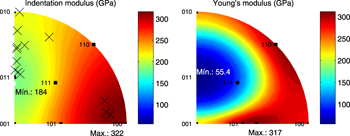Crossref Citations
This article has been cited by the following publications. This list is generated based on data provided by
Crossref.
Leineweber, A.
2012.
Anisotropic microstrain broadening in cementite, Fe3C, caused by thermal microstress: comparison between prediction and results from diffraction-line profile analysis.
Journal of Applied Crystallography,
Vol. 45,
Issue. 5,
p.
944.
Laschet, G.
Fayek, P.
Henke, T.
Quade, H.
and
Prahl, U.
2013.
Derivation of anisotropic flow curves of ferrite–pearlite pipeline steel via a two-level homogenisation scheme.
Materials Science and Engineering: A,
Vol. 566,
Issue. ,
p.
143.
Jiang, Chao
and
Srinivasan, Srivilliputhur G.
2013.
Unexpected strain-stiffening in crystalline solids.
Nature,
Vol. 496,
Issue. 7445,
p.
339.
Tacq, Jeroen
Kriška, Martin
and
Seefeldt, Marc
2013.
Synchrotron Diffraction Study of the Cementite Phase in Cold Drawn Pearlitic Steel Wires.
Materials Science Forum,
Vol. 768-769,
Issue. ,
p.
380.
Laschet, Gottfried
Shukla, Mohit
Henke, Thomas
Fayek, Patrick
Bambach, Markus
and
Prahl, Ulrich
2014.
Impact of the Microstructure on the U–O Forming Simulations of a Ferrite–Pearlite Pipeline Tube.
steel research international,
Vol. 85,
Issue. 6,
p.
1083.
Tacq, J.
Kriška, M.
and
Seefeldt, M.
2014.
Residual Stress in the Cementite Phase of Cold Drawn Pearlite*.
HTM Journal of Heat Treatment and Materials,
Vol. 69,
Issue. 2,
p.
64.
Leineweber, A.
Shang, S.L.
and
Liu, Z.K.
2015.
Elastic anisotropy of iron carbides with trigonal-prismatic coordination of C by Fe.
Journal of Alloys and Compounds,
Vol. 633,
Issue. ,
p.
390.
Weisser, M.A.
Van Petegem, S.
Cervellino, A.
and
Van Swygenhoven, H.
2015.
On the origin of cementite diffraction peak broadening during tensile deformation at ambient temperatures.
International Journal of Plasticity,
Vol. 66,
Issue. ,
p.
138.
Leineweber, Andreas
2016.
Thermal expansion anisotropy as source for microstrain broadening of polycrystalline cementite, Fe3C.
Journal of Applied Crystallography,
Vol. 49,
Issue. 5,
p.
1632.
Borchers, Christine
and
Kirchheim, Reiner
2016.
Cold-drawn pearlitic steel wires.
Progress in Materials Science,
Vol. 82,
Issue. ,
p.
405.
Mauger, L.
Herriman, J. E.
Hellman, O.
Tracy, S. J.
Lucas, M. S.
Muñoz, J. A.
Xiao, Yuming
Li, J.
and
Fultz, B.
2017.
Phonons and elasticity of cementite through the Curie temperature.
Physical Review B,
Vol. 95,
Issue. 2,
Taniyama, Akira
Takayama, Toru
Arai, Masahiro
and
Hamada, Takanari
2017.
Deformation Behavior of Cementite in Deformed High Carbon Steel Observed by X-ray Diffraction with Synchrotron Radiation.
Metallurgical and Materials Transactions A,
Vol. 48,
Issue. 10,
p.
4821.
Huang, Linghui
Tu, Yiyou
Zhang, Qi
Zhou, Xuefeng
and
Jiang, Jianqing
2018.
Unobvious elastic anisotropy of measured single–crystal cementite.
Materials Research Express,
Vol. 6,
Issue. 1,
p.
016531.
Umemoto, Minoru
Kruger, Silvio E.
and
Ohtsuka, Hideyuki
2019.
Ultrasonic study on the change in elastic properties of cementite with temperature and Mn content using nearly full density polycrystalline bulk samples.
Materials Science and Engineering: A,
Vol. 742,
Issue. ,
p.
162.
Guelton, Nicolas
and
François, Marc
2020.
Microstructure–Property Relationship in Cold-Drawn Pearlitic Steel Wires.
Metallurgical and Materials Transactions A,
Vol. 51,
Issue. 4,
p.
1543.
Bhadeshia, H. K. D. H.
2020.
Cementite.
International Materials Reviews,
Vol. 65,
Issue. 1,
p.
1.
Ohmura, Takahito
and
Wakeda, Masato
2021.
Pop-In Phenomenon as a Fundamental Plasticity Probed by Nanoindentation Technique.
Materials,
Vol. 14,
Issue. 8,
p.
1879.
Umemoto, Minoru
and
Ohtsuka, Hideyuki
2021.
Mechanical Properties of Cementite.
Tetsu-to-Hagane,
Vol. 107,
Issue. 4,
p.
269.
Umemoto, Minoru
and
Ohtsuka, Hideyuki
2022.
Mechanical Properties of Cementite.
ISIJ International,
Vol. 62,
Issue. 7,
p.
1313.
Tsybenko, Hanna
Tian, Chunhua
Rau, Julia
Breitbach, Benjamin
Schreiber, Paul
Greiner, Christian
Dehm, Gerhard
and
Brinckmann, Steffen
2022.
Deformation and phase transformation in polycrystalline cementite (Fe3C) during single- and multi-pass sliding wear.
Acta Materialia,
Vol. 227,
Issue. ,
p.
117694.





